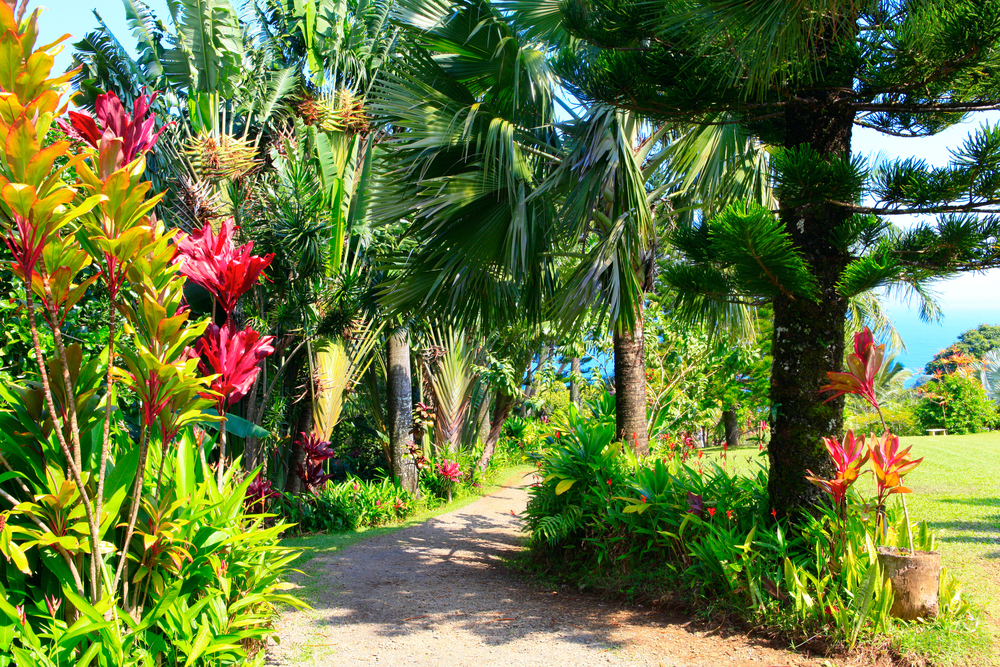Give Your Tropical Garden a Gift This Holiday
It is always a good idea to keep an eye on your garden to make sure there are sufficient water and nutrients available. Now is a good time to give your garden the Christmas gift of love and attention by being observant.
Some parts of East Hawaii have experienced more than enough rain this year. Hilo has had record rainfall, but it only takes a few weeks of dry weather to see water stress when it occurs. Folks are becoming more aware of the importance to be water-wise when it comes to gardening.
Last year, parts of West Hawaii were experiencing a long spell of water restrictions because of pump problems. Now that the winter dry season is again upon West Hawaii, landscapes are showing signs of stress.
With global climate change we really don’t know what the future might bring, but scientists are saying that temperature extremes and more drought conditions are likely.
Urbanization of Hawaii is impacting Kona and Hilo, but Puna, Kohala and other population areas on the Big Island are showing signs of construction and a trend toward degreening. With water rates on the increase, some folks might even consider concrete lawns.
But don’t be hasty.
Remember that plants are the lungs of the planet. We need plants to sequester carbon and produce oxygen.
You can do your part to produce oxygen and have a beautiful yard even if you live in a drier area. It’s just a matter of planning and proper planting.
A garden planted with no thought given to dry spells will do well in rainy periods but deteriorates without irrigation in dry periods, even in East Hawaii. Fortunately, many garden plants in Hawaii are fairly hardy when it comes to short water supply, so we have a long list of plants to assist us.
There are two factors that make these plants able to survive moisture stress.
First, some plants are notably resistant to drought. This quality is centered largely in the cellular structure and has a bearing on the economy with which the plant functions. Some plants have the ability to carry through extended dry periods because of a happy faculty of closing the pores of the leaf against transpiration, or turn the leaf back or edge-on to the sun. Others root deeply to tap into deeper soil and have available for dry periods any accumulated moisture of the subsoil.
The amount of water conducted away from the soil and the plant surface depends on wind movement, wind speed, temperature of the air and the vapor pressure or relative humidity of the atmosphere. If water is conducted away by rapid wind movement or low relative humidity, we can have high rates of water use.
Plants that are tolerant of salty beach conditions often use less water than many soft, luxuriant jungle plants because they are streamlined for water conservation. However, plants such as the bird of paradise and monstera give the luxuriant look and are still drought resistant. Many palms also have this quality.
What can we do in managing the soil to take advantage of our knowledge of the factors affecting water use rates?
First of all, we can irrigate only when the soil moisture becomes low and plants begin to show evidence of wilt during the hottest part of the day. This forces deep rooting. Daily watering tends to promote shallow roots.
We can understand that we will have to irrigate sooner following a previous irrigation than following a general rainfall. And we can provide soil with good physical and chemical properties for deep rooting of plants.
Proper fertilization will help accomplish this. Also, poor soils should be improved with the necessary amendments to help plants develop good root systems. Addition of well-rotted organic matter or compost often helps increase moisture and nutrient-holding capacity.
In many Hawaii soils, available phosphorus is lacking. This is essential to root growth, so addition of this element is particularly important. The use of mulches also will help conserve soil moisture.
Will the time come when we are islands teaming with too many people?
Will we be so limited in food and water that we can no longer have gardens or parks or landscaped highways?
For assistance in assessing water and nutrient needs as well as selecting the right plants, contact the University of Hawaii Master Gardener Helpline. The number in Kona is 322-4893. In Hilo, call 981-5199.

